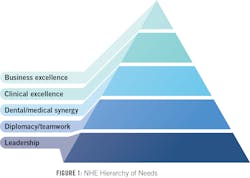I believe that dental hygiene excellence is a requirement. I will expand on that and say that dental hygiene excellence is a manifesto, a creed, a mantra, and a promise. At the core of our profession is a band of professionals committed to excellence for ourselves, our patients, and our profession.
What embodies excellence, and how does this concept correlate to the profession of dental hygiene? After conducting a nationwide survey and compiling the data, I put into words (figure 1), the National Hygiene Excellence (NHE) Hierarchy of Needs. This hierarchy comprises the five core pillars of hygiene excellence. One can look at these pillars that are similar to Maslow’s hierarchy of needs diagram, with leadership at the bottom, stacked by diplomacy/teamwork, dental/medical synergy, clinical excellence, and business excellence.
At a foundational level, it all begins with leadership. We all have a leadership style, and it is essential that we understand our leadership style and the leadership style of those around us.
Once we have accepted leadership, it’s time to stack diplomacy and teamwork on top of leadership. We have moved past the days of the siloed hygienists and divas. Today’s hygienists need to ask for meetings with their dentists to discuss the vision for their practices, establish action steps and metrics, and set a meeting to share this information with the entire team.
Now that you have put leadership together with diplomacy and teamwork, you’re ready to champion our profession's future concerns and growth opportunities. It is time to understand that as dental hygienists we are dental/medical health-care providers. We see the patients more than other health-care providers, and we have an excellent opportunity to collaborate with the medical community to elevate patient outcomes and overall health care.
Using national hygiene excellence protocols supports excellent patient care by ensuring a systematic, whole-team approach to clinical care. All dental hygienists need to understand how the clinical side of dentistry works, and why and when to promote adjunct services. Make sure to track key performance indicators (KPIs) in your hygiene department to ensure that you are doing everything you can to identify and mitigate risk factors for your patients.
Finally, it’s time to get down to business. Hygienists need to view the hygiene department as a business within a business. Only you can effect a fundamental change in your hygiene department for yourself and your patients. It is paramount that all dental hygienists understand the importance of having a solid business model supported by KPIs and an informed and dynamic team.
Mastering the five core pillars of dental hygiene excellence is the embodiment of and requirement for national hygiene excellence. Our commitment to excellence needs to be our manifesto, creed, mantra, and promise.
As founder and CEO of National Hygiene Excellence (NHE), I invite you to take a journey with thousands of like-minded dental professionals as we change the way we build sustainable, scalable, and ultimately, patient-centered practices grounded by our commitment to elevate patient outcomes.
NHE members engage with and learn from the brightest minds in dentistry and hygiene while developing core skills in clinical excellence, leadership, business acumen, and patient advocacy. We strategically drive ROI through critical investment in professional development through our interactive educational programs. Visit National Hygiene Excellence to learn more and become a member of our growing community of leaders!
Editor's note: This article appeared in the March 2022 print edition of RDH magazine. Dental hygienists in North America are eligible for a complimentary print subscription. Sign up here.













